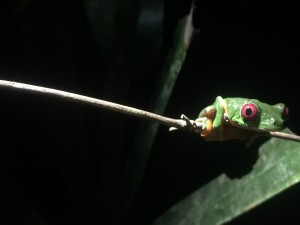Visiting the Mira Flores locks of the Panama Canal today was truly a different experience from how the first 8 days of our tour through the neotropics have been. Instead of spending the day trekking through a humid, shady jungle, we watched as a massive feat of human engineering managed to move hundreds of tons of cargo through a waterway never originally meant to carry ships from one bordering ocean to the next. The canal is deeply ingrained in much of Panama’s identity. Because of our host country’s placement on the thinnest part of the isthmus between North and South America, it has been used as a Pacific-to-Atlantic crossing of sorts for traders and conquistadors since the early days of Spanish exploration in the 17th century, when the new world explorers needed a more efficient way of transporting gold from places like Peru back home to Spain. Originally beginning as a land route, the Panama railway was built along a similar route to today’s canal, and eventually plans were drawn up by the French to dredge a complete waterway across the landscape. Yellow Fever and rain forest climate conditions bankrupted several of these huge attempts, but eventually the U.S. would assist Panama with their liberation from Colombia in the early 1900s and redesign and complete the Panama Canal in 1914.
Today, close to 5% of all world shipping passes through the canal every year. Its hard to not only be in sheer awe of the huge mechanical locks, however a part of me knew that the canal had to have negative impacts somewhere, and unfortunately one of those areas is the subject of our course – Tropical Field Ecology. But before jumping to conclusions and shouting at canal workers about water waste and deforestation, One must consider both sides of this story. The canal has cost this region thousands of acres of pristine old-growth rain forests, entire valley stream ecosystems and perhaps billions of gallons of fresh water produced by the watershed flowing into the locks and out in the salty ocean. This canal is also responsible for the well-being of countless Panamanian citizens, and for even greater numbers of people benefiting from trade through the locks. It seems the human-well-being element and the conservation elements of especially large scale projects like the Panama Canal are almost always at odds with each other.
Recently (really recently. This year actually), Panama completed a huge expansion project, widening the canal by adding parts of a completely new channel adjacent to the original canal path and
building new lock systems to allow larger, heavier ships laden with more goods. This means more forest clearing, more dredging the bottom of native rivers to make room for boats with lower bottoms, and generally more usage of the locks. However, this is also anticipated to mean massive economic growth in Panama, helping to alleviate massive issues with poverty experienced here. Putting ourselves in a poor Panamanian’s shoes helps give a broader perspective on these view – what would you rather have in your home country, Ocelots or job opportunities so you’re able to feed your family at night? The field of Conservation Biology helps to looks at both of these ideals and create a conservation plan for a threatened species. Uneducated “save the one individual animal” hippie stances are not enough and will not stand up to those in our way of achieving our goal of ecological conservation, but neither will standing by without prodding for changes. The Panama Canal authority has designed the newer locks to recycle fresh water instead of allowing it to fall out to sea, and the expansion projects working into the forests are much more specific and studied about what part of the landscape they’re taking down. Things get done correctly in a healthy way when you consider the both sides.
Check out this Nat. Geographic article on this dichotomy, before the project was finished. http://news.nationalgeographic.com/news/2007/06/070627-panama-canal_2.html





